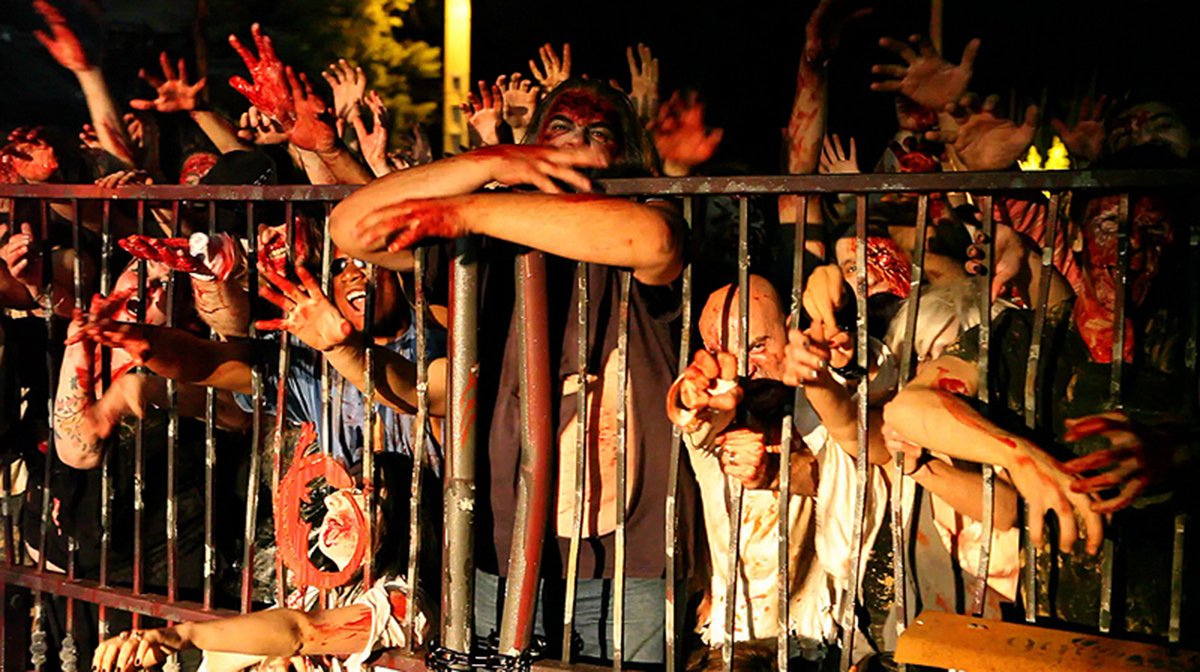Back in 2012, newspapers reported that a mystery disease was turning growing numbers of East African children into "zombies". They were talking about a disease known as Nodding Syndrome, a phenomenon that first appeared in Tanzania in the 1960s and later reared its head in Sudan and Uganda.

According to the World Health Organization, Nodding Syndrome typically "affects children between the ages of 5 and 15 years old, causing progressive cognitive dysfunction, neurological deterioration, stunted growth and a characteristic nodding of the head". Children affected by this bizarre disease appear to fall asleep, closing their eyes and nodding their heads even when they are actually awake. The victims are confused and have the compulsion to wander around aimlessly — like zombies. The scariest thing about Nodding Syndrome is that its cause hasn't been discovered yet.
Nodding Syndrome is certainly interesting as well as scary, but is it also a sign that a real-life zombie outbreak could sweep across the globe one day?
What Exactly Are Zombies?
We all know zombies from the movies. Less well-known is the fact that the word "zombie" comes from Haiti. The creole "zonbi" turned into the Haitian French "zombi". A British poet writing about the history of Brazil first introduced the word to the English language in 1819.
In Haitian folklore, zombies are animated corpses made to move by magic, witchcraft, or voodoo. These corpses were said to be under the control of the magician, and to have no soul or free will.
The zombies we know from the movies are a little different. They're dead, yes, but they're not under control of a witch doctor. They don't appear to engage in any meaningful conversation, but they do have an insatiable craving for human flesh. These "living dead" don't just decompose and stop moving after a while; they seem to have the capacity to go on forever.
Kids with Nodding Syndrome may look like zombies from movies, then, but they don't qualify for that title because they're neither dead nor cannibalistic. The eerie similarities are undeniable though, especially if you look at more recent media portrayals of the zombie phenomenon, like the TV series The Walking Dead. Modern zombie films don't just want to creep you out. They're looking for that extra fear factor and want to make zombies look a little more scientific. Saying a virus has turned dead people into zombies is one way in which this can be achieved.
See Also: Krokodil, The World's Most Dangerous Drug
Could that actually happen, for really real? It's an nice fantasy to explore. Let's be honest and say that it's not possible for actual dead people to move about eating folks, controlled by a virus, fungus, or parasite. Still, individual "zombie symptoms" can indeed occur in humans and animals. Since they are science-fact rather than fiction, this is no less frightening than real zombies. Parasites, viruses, bacteria and fungi could all lead to devastating and incredibly frightening consequences.
What Could Cause Zombie-Like Symptoms For Real?
Parasites
Some parasites are perfectly happy living out their lives inside or on top of their hosts without causing them too much damage, while others kill their hosts. You might be surprised to hear that both types of parasites can significantly alter their hosts' behavior, essentially controlling their bodies.

Leucochloridium paradoxum, a parasitic flatworm, demonstrates this very nicely. Commonly known as the green-banded broodsac, this flatworm spends most of its life inside a bird, not really bothering it. The trouble starts when it reproduces, and its eggs are pooped out. Once eaten by a snail, the parasite continues its life cycle. The "broodsac" spreads out into the snail's eye, where it starts pulsing vigorously — making it look like a tasty worm for birds to eat.
While that's frightening enough in itself, the parasite also alters the snail's behavior! Snails naturally prefer darker environments where they are safe from predators, but this parasite compels the snail to sit out in the light. A bird will soon come along, eating the parasite along with the snail. The parasite's life cycle is now complete.
This might sound like a mere curiosity, but if parasites figured out a way to act out a similar play within a human host, humans could behave much like the zombies you've seen in the movies.
Toxoplasma gondii is another great example of a parasite that exercises mind control over its host. You've probably heard about this one, because it causes the toxoplasmosis that's so common in domestic cats — an infection that can also be dangerous for unborn humans. Toxoplasma spends most of its time in cats. As with the previously discussed parasite, its eggs are shed through feces. They're often encountered by rodents, and make their way back to a cat when that cat eats the rodent.
Research shows that rodents infected with toxoplasma behave differently. Rather than staying away from cats, they're actually drawn to the smell of cat urine. The parasite clearly benefits from this, but there's more. Humans aren't involved in the life cycle of toxoplasma gondii in any way, yet Czech research shows that the parasite does alter human behavior:
- Males infected with the parasite were found to be more likely to break rules, behave jealously, and have suspicious and dogmatic views.
- In contrast, females who encountered toxoplasma tended to be "warm-hearted, outgoing, conscientious, persistent, and moralistic".
- Humans of both sexes were more likely to be clumsy and accident prone, and to lack concentration if they were infected with the parasite.
See Also: Intestinal Infections with Tapeworm Parasites
How does that benefit toxoplasma, one might ask? One explanation is that large cats might have eaten humans earlier in history, and another is that the parasite is simply unaware that humans are a dead-end host. In any case, these findings are quite disturbing!
These two examples aren't the only ones by any means. They show that parasites have the capability to mess with human and animal behavior. Can we really rule out that some parasites will evolve to make humans act in zombie-like ways in the future?
Zombie-Like Viruses, Prion Diseases And Fungi
Viruses
We know that viruses make us ill, but we don't typically think of them as something that alters our behavior — beyond forcing us to spend time in bed and in the bathroom, that is. Yet viruses definitely have the potential to "take control" of their host body, and you just have to think of rabies to know that this is true.

What do rabid dogs and bats do after infection? Fever, vomiting, loss of appetite, a headache and pain at the bite site are some of the early symptoms. By the time the virus reaches the neurological stage, animal victims become terrified of water, anxious, hyperactive and... terribly aggressive. It's this "mad" stage of rabies that ensures the virus will have a new host. Without inducing aggression, rabies might not have a very good chance of being transmitted.
People infected with rabies experience most of the above-mentioned symptoms if they don't get vaccinated in time, and they do also become very agitated. They don't have a tendency to bite others, but rabies does show that a virus has the potential to make victims persistently aggressive — just like zombies are.
Fungi
Real zombies would have to be infected with something that's able to control the whole brain and body even after death. In this respect, both parasites and viruses become fairly useless after their victim snuffs it. You can still get a virus from a dead body, and parasites might consume a host's body after killing it. Both these occurrences have an obvious expiry date, however.
The "zombie fungus", Ophiocordyceps unilateralis, manipulates the behavioral patterns of the ants it infects. These ants leave their nests and foraging trails in search for a temperature and humidity level that's perfect for the fungus! After a while, the poor zombie ant bites into the vein of a leaf, where it continues to hang until it dies. Meanwhile, the fungus is free to proliferate.
Cordyceps, meanwhile, represents a whole species of fungus. They mainly live off spiders and other arthropods, where the vegetative part of the fungus eventually takes over most of its victim's internal structures. Just before the victim dies, it marches itself to a plant, where it attaches itself and dies. The fruit bodies of the fungus, now sticking out of the victim's body, then have the chance to distribute their spores.
See Also: Learn how to get rid off fungal infection
Prion Diseases
Most people have heard of Creutzfeldt-Jakob or "Mad Cow" disease, but you may not be aware that it's neither a virus nor a bacterium. Mad Cow disease belongs to a a separate category: prion diseases. Prions are infectious agents made up of misfolded proteins. Like the other categories we discussed, prions can do creepy things to the body.
Mad Cow disease can infect people too, and it can cause dementia, hallucinations, and even psychosis. Kuru is perhaps the most zombie-like prion though. Transmitted through ritualistic postmortem cannibalism practiced by some tribes in Papua New Guinea, kuru makes people shake and laugh, and causes them to become slow and numb. The skin lesions we're accustomed to seeing in zombies are also present.
OK, OK, this is all very far-fetched. These conditions are all very frightening, but none of them really turn people into zombies. It's just as well that zombies belong squarely to the realms of fiction and nightmares. It's clear that we have plenty of real frightening conditions to worry about, after all!
- Photo courtesy of thierry ehrmann by Flickr : www.flickr.com/photos/home_of_chaos/4754600806
- Photo courtesy of Robert Bejil by Flickr : www.flickr.com/photos/robnas/5291417046
- Photo courtesy of Esparta Palma by Flickr : www.flickr.com/photos/esparta/3483781370
- www.dailymail.co.uk/news/article-2120903/Mystery-nodding-disease-turning-children-zombies-Uganda.html
- www.who.int/neglected_diseases/diseases/nodding_syndrome/en/
- www.cdc.gov/parasites/toxoplasmosis/biology.html
- http://www.ncbi.nlm.nih.gov/pmc/articles/PMC2526142/


Your thoughts on this